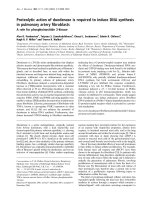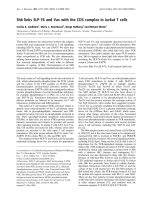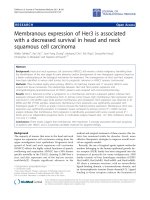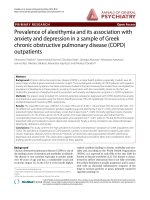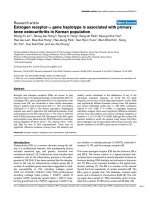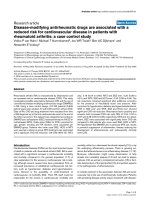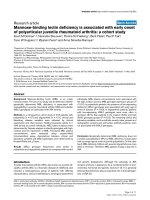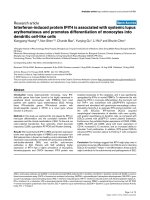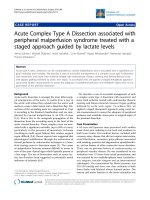Báo cáo y học: "Estrogen receptor-α gene haplotype is associated with primary knee osteoarthritis in Korean population" docx
Bạn đang xem bản rút gọn của tài liệu. Xem và tải ngay bản đầy đủ của tài liệu tại đây (155.83 KB, 7 trang )
Open Access
Available online />R415
Vol 6 No 5
Research article
Estrogen receptor-α gene haplotype is associated with primary
knee osteoarthritis in Korean population
Sheng-Yu Jin
*1
, Seung-Jae Hong
*2
, Hyung In Yang
3
, Sang-do Park
3
, Myung-Chul Yoo
4
,
Hee Jae Lee
1
, Mee-Suk Hong
1
, Hae-Jeong Park
1
, Seo Hyun Yoon
1
, Bum-Shik Kim
1
, Sung-
Vin Yim
1
, Hun-Kuk Park
1
and Joo-Ho Chung
1
1
Kohwang Medical Research Institute, Department of Pharmacology, College of Medicine, Kyung Hee University, Seoul, Korea
2
Department of Internal Medicine, College of Medicine, Pochon CHA University, Sungnam, Korea
3
Division of Rheumatology, Department of Internal Medicine, College of Medicine, Kyung Hee University, Seoul, Korea
4
Department of Orthopedic Surgery, College of Medicine, Kyung Hee University, Seoul, Korea
* Contributed equally
Corresponding author: Joo-Ho Chung,
Received: 19 Feb 2004 Revisions requested: 5 Apr 2004 Revisions received: 26 May 2004 Accepted: 8 Jun 2004 Published: 19 Jul 2004
Arthritis Res Ther 2004, 6:R415-R421 (DOI 10.1186/ar1207)
http://arthr itis-research.com/conte nt/6/5/R415
© 2004 Jin et al.; licensee BioMed Central Ltd. This is an Open Access article: verbatim copying and redistribution of this article are permitted in all
media for any purpose, provided this notice is preserved along with the article's original URL.
Abstract
Estrogen and estrogen receptors (ERs) are known to play
important roles in the pathophysiology of osteoarthritis (OA). To
investigate ER-α gene polymorphisms for its associations with
primary knee OA, we conducted a case–control association
study in patients with primary knee OA (n = 151) and healthy
individuals (n = 397) in the Korean population. Haplotyping
analysis was used to determine the relationship between three
polymorphisms in the ER-α gene (intron 1 T/C, intron 1 A/G and
exon 8 G/A) and primary knee OA. Genotypes of the ER-α gene
polymorphism were determined by PCR followed by restriction
enzyme digestion (PvuII for intron 1 T/C, XbaI for intron 1 A/G,
and BtgI for exon 8 G/A polymorphism). There was no
significant difference between primary knee OA patients and
healthy control individuals in the distribution of any of the
genotypes evaluated. However, we found that the allele
frequency for the exon 8 G/A BtgI polymorphism (codon 594)
was significantly different between primary knee OA patients
and control individuals (odds ratio = 1.38, 95% confidence
interval = 1.01–1.88; P = 0.044). In haplotype frequency
estimation analysis, there was a significant difference between
primary knee OA patients and control individuals (degrees of
freedom = 7, χ
2
= 21.48; P = 0.003). Although the number OA
patients studied is small, the present study shows that ER-α
gene haplotype may be associated with primary knee OA, and
genetic variations in the ER-α gene may be involved in OA.
Keywords: estrogen receptor, haplotype, knee osteoarthritis, polymorphism
Introduction
Osteoarthritis (OA) is a common disorder among the eld-
erly. It is multifactorial disorder, with predisposing factors
included advanced age, and genetic, hormonal and
mechanical factors [1,2]. Furthermore, recent studies have
revealed a role for the inflammatory process in the patho-
genesis of OA [3-5]. It has been reported that the develop-
ment of OA may be influenced by multiple genes [6]. A
number of candidate genes have been suggested to medi-
ate susceptibility to OA, including collagen genes
(COL1A1, COL2A1, COL9A1, COL11A2), and the genes
encoding cartilage matrix protein 1 (CMP1), vitamin D
receptor (VDR), insulin-like growth factor-1 (IGF1), trans-
forming growth factor-β
1
(TGF
β
1), aggrecan-1 (AGC1), tis-
sue inhibitor of metalloproteinase 3 (TIMP3), interleukin-1
receptor (IL1R), and the estrogen receptor [6].
The human estrogen receptor (ER) has two isoforms: ER-α
and ER-β. The former isoform is a ligand-activated tran-
scription factor composed of several important domains for
hormone binding, DNA binding, and activation of transcrip-
tion [7]. ER-α is an important mediator in the signal trans-
duction pathway [7]. The ER is a member of the steroid/
thyroid hormone superfamily of nuclear receptors [8]. The
ER-α gene is greater than 140 kilobases, contains eight
exons, and is located on chromosome 6q25 [9]. The cod-
ing region has a length of 1785 nucleotides, and it is trans-
lated into a protein of 595 amino acids and 66 kDa [10].
CI = confidence interval; df = degrees of freedom; ER = estrogen receptor; OA = osteoarthritis; OR = odds ratio; PCR = polymerase chain reaction.
Arthritis Research & Therapy Vol 6 No 5 Jin et al.
R416
Several variations in the DNA sequence of the ER-α gene
have been reported [11,12]. A few reports have examined
the association between ER-α gene polymorphisms and
OA; the findings are controversial. Ushiyama and co-work-
ers [13] reported associations between a genotype of PvuII
and XbaI polymorphisms in intron 1 of the ER-α gene and
generalized OA. Bergink and co-workers [14] found that an
ER-α haplotype of PvuII and XbaI polymorphisms was
associated with radiographic OA of the knee. However,
Loughlin and co-workers [15] found no association
between ER-α gene polymorphisms and idiopathic OA.
Some studies of BtgI polymorphisms have been conducted
in other diseases. Cancel-Tassin and co-workers [16]
reported that a BtgI (594 A/G) polymorphism was not
associated with risk for prostate cancer. Tanaka and col-
leagues [17] reported similar findings in prostate cancer
patients. In another study, the BtgI (594 A/G) polymor-
phism was not associated with renal cell carcinoma [18].
Curran and co-workers [19] reported an association of A/
G polymorphism in exon 8 of the ER gene with sporadic
breast cancer. However, no findings regarding the relation-
ship between exon 8 A/G polymorphism and OA have been
reported.
In the present study, we first analyzed the association
between the exon 8 G/A BtgI polymorphism (database-sin-
gle nucleotide polymorphism number rs2228480; codon
594) of the ER-α gene and primary knee OA in patients
from the Korean population. We also investigated the asso-
ciation between haplotypes of three polymorphisms (PvuII
in intron 1, XbaI in intron 1, and BtgI in exon 8) and primary
knee OA.
Materials and methods
Study subjects
A total of 151 patients with primary knee OA (98 women
and 53 men) from the Korean population were included in
the study. Patients were examined at the Rheumatology
Clinic in Kyung Hee University Medical Center, Seoul,
Korea. In total, 397 control individuals (207 women and
190 men) underwent the 2003 health examination. OA was
diagnosed according to American College of Rheumatol-
ogy criteria, which include primary OA with any symptom
and/or sign of OA, positive finding on radiographs accord-
ing to the Kellgren-Lawrence grading [20], and no evi-
dence of arthritis due to other disease. The study was
approved by the ethics review committee of the Medical
Research Institute, Kyung Hee University Medical Center,
Seoul, Korea.
Clinical information and classification of primary knee oste-
oarthritisThe age at onset of OA is important clinically
because it is associated with long-term prognosis. During
the study, we were able to identify the current age and age
at onset of disease in the 151 knee OA patients by individ-
ual interview conducted at our outpatient clinic. The current
age of OA patients (mean ± standard deviation) was 58.8
± 9.6 years, and the age at onset of OA was 52.0 ± 9.5
years. We therefore stratified clinical data according to
mean onset age of disease: older or younger than 52.0
years. The group with disease onset at age <52.0 years
was defined as the 'early' onset, and the group of disease
onset at age >52.0 years was defined as the 'late' onset
group.
The Kellgren-Lawrence grade represents disease severity,
as reflected on radiographs, and Lequesne's functional
index represents functional or symptomatic status of
patients [21]. Radiographic findings of OA were classified
into mild (Kellgren-Lawrence grade 1 or 2) or severe (Kell-
gren-Lawrence grade 3 or 4). The functional or sympto-
matic status of OA patients was classified as functionally or
symptomatically good (Lequesne's functional index = 10)
or poor (Lequesne's functional index > 10; Table 1).
Table 1
Clinical characteristics of the patients with primary knee osteoarthritis patients
Characteristic Findings
Age (years) 58.8 ± 9.6
Number women/men (n)98/53
Age at onset age (years) 52.0 ± 9.5
Body mass index (kg/m
2
) 25.2 ± 2.9
Duration of osteoarthritis (years) 6.8 ± 5.9
Kellgren-Lawrence grade (n): 1/2/3/4 6/84/56/5
Lequesne's index 10.2 ± 2.5
A total of 151 patients with primary knee osteoarthritis were included. Values are expressed as mean ± standard deviation or as numbers.
Available online />R417
Analysis of estrogen receptor-α gene polymorphisms
Genomic DNA was prepared from whole blood samples
using the NucleoSpin DNA isolation kit (Macherey-Nagel
GmbH & Co., Düren, Germany). PCR amplifications were
performed using 50 ng genomic DNA in a 30 µl reaction
volume containing 0.5 µl 10 pmol sense primer, 0.5 µl 10
pmol antisense primer, 0.5 µl 2.5 mmol/l dNTP (Takra,
Shiga, Japan), 1 U Taq DNA polymerase (Neurotics Inc.,
Seoul, Korea), and in buffer containing 25 mmol/l MgCl
2
,
750 mmol/l Tris-HCl (pH 9.0), 150 mmol/l ammonium sul-
fate, and 1 mg/ml bovine serum albumin. Samples were
subjected to 35 cycles of amplification in GeneAmp PCR
system 2700 (Applied Biosystems, Foster, CA, USA). PCR
primers used in the study are listed in Table 2[19,22]. The
PCR products were digested under the conditions speci-
fied by the enzyme supplier (New England Biolabs Inc, Bev-
erly, MA, USA). Restriction fragments were separated by
agarose gel electrophoresis and ethidium bromide staining.
Statistical analysis
For the case–control association study, the significance of
differences in allelic and genotypic frequencies between
OA patients and control populations was determined using
standard χ
2
tests. We used the EH program [23] to inves-
tigate the relative risks associated with haplotypes. P <
0.05 was considered statistically significant.
Results
Distribution of estrogen receptor-α genotypes in
osteoarthritis patients and control individuals
As shown in Table 3, three single nucleotide polymor-
phisms were identified in ER-α intron 1 (T/C, A/G) and
exon 8 (G/A). When the allele frequency of the exon 8 G/A
BtgI polymorphism was compared between OA patients
and control individuals, a significant difference was
observed (odds ratio [OR] = 1.38, 95% confidence interval
[CI] = 1.01–1.88; P = 0.044). However, the genotype dis-
tribution did not exhibit a significant difference between OA
patients and control individuals (P = 0.13). Observed gen-
otype and allele frequencies for the intron 1 T/C PvuII and
the intron 1 A/G XbaI polymorphisms were not significantly
different between OA patients and control individuals
(Table 3). There was no evidence of deviation from Hardy-
Weinberg equilibrium in healthy control individuals (for
intron 1 T/C PvuII polymorphism, P = 0.85; for intron 1 A/
G XbaI polymorphism, P = 0.99; and for exon 8 G/A BtgI
polymorphism, P = 0.77).
Estrogen receptor-α gene polymorphisms and sex of
osteoarthritis patients
As shown in Table 4, the observed genotype distribution (P
= 0.04) and allele frequency (OR = 1.89, 95% CI = 1.15–
3.11; P = 0.01) for the exon 8 G/A BtgI polymorphism were
significantly different between male OA patients and male
control individuals, whereas those in females exhibited no
significant difference. We compared genptype distribu-
tions and allele frequencies for the intron 1 T/C PvuII and
the intron 1 A/G XbaI polymorphisms. There were no signif-
icant differences in the polymorphisms between OA
patients and controls of the same sex.
Estrogen receptor-α gene polymorphisms and risk for
late onset osteoarthritis
Late onset OA patients were defined as those with disease
onset at age above 52 years, whereas early onset OA
patients had their disease onset at age under 52 years.
When comparing allele frequency of the exon 8 G/A BtgI
polymorphism between late onset OA patients and control
individuals, a significant difference was observed (OR =
1.62, 95% CI = 1.07–2.46; P = 0.021). However, the
genotype distribution did not exhibit a significant difference
between OA patients and control individuals (P = 0.06).
The genotype distributions and allele frequencies of the
intron 1 T/C PvuII and the intron 1 A/G XbaI polymorphisms
were not significantly different between late onset OA
patients and control individuals. When comparing geno-
type distributions and allele frequencies of the intron 1 T/C
PvuII, the intron 1 A/G XbaI, and the exon 8 G/A BtgI poly-
morphisms between early onset OA patients and control
individuals, no significant difference was observed (Table
4).
Estrogen receptor-α gene polymorphisms and risk for
radiographically severe osteoarthritis
Patients with radiographically severe OA were defined as
those whose Kellgren-Lawrence grade was 3 or 4, whereas
Table 2
Sequences of primers used for estrogen receptor-α genotyping
Polymorphism site Primer sets Annealing temperature (°C) Restriction enzyme Allele size (bp)
Intron 1 T/C 5'-ctgccaccctatctgtatcttttcctattctcc-3'
5'-tctttctctgccaccctggcgtcgattatctga-3'
64 PvuII T: 936 + 438
C: 1374
Intron 1 A/G 5'-ctgccaccctatctgtatcttttcctattctcc-3'
5'-tctttctctgccaccctggcgtcgattatctga-3'
64 XbaI A: 981 + 393
G: 1374
Exon 8 G/A 5'-gaggagacggaccaaagccac-3'
5'-gccattggtgttggatgcatg-3'
63 BtgI G: 129 + 98
A: 227
bp, base pairs.
Arthritis Research & Therapy Vol 6 No 5 Jin et al.
R418
radiographically mild OA was defined as Kellgren-Law-
rence grade 1 or 2. When comparing genotype distribu-
tions and allele frequencies of the intron 1 T/C PvuII, the
intron 1 A/G XbaI, and the exon 8 G/A BtgI polymorphisms
between patients with mild OA and control individuals, no
significant difference was observed (Table 4). The geno-
type distributions and allele frequencies of the intron 1 T/C
PvuII, the intron 1 A/G XbaI, and the exon 8 G/A BtgI poly-
morphisms did not exhibit significant differences between
patients with severe OA and control individuals (Table 4).
Estrogen receptor-α gene polymorphisms and risk for
functionally poor osteoarthritis
OA patients who were functionally or symptomatically poor
(poor index) were defined as those who with a Lequesne's
functional index score over 10, whereas those who were
functionally or symptomatically good (good index) had a
Lequesne's functional index score less than or equal to 10.
Genotype distributions and allele frequencies of the intron
1 T/C PvuII, the intron 1 A/G XbaI, and the exon 8 G/A BtgI
polymorphisms between OA patients with a good and
those with a poor index, and control individuals were not
significantly different (Table 4).
Estrogen receptor-α haplotype analysis in patients with
primary knee osteoarthritis
Table 5 shows the frequency of each haplotype. The differ-
ence was significant between all OA patients combined
and control individuals (degrees of freedom [df] = 7, χ
2
=
21.48; P = 0.003). There was no significant difference
between female patients and female control individuals (df
= 7, χ
2
= 8.22; P = 0.31). However, there was a significant
difference between male OA patients and male control indi-
viduals (df = 7, χ
2
= 16.76; P = 0.019; Table 5).
The late onset, radiographically severe, and poor index sub-
groups of OA patients exhibited significant differences in
haplotype distribution (Table 6). There was a significant dif-
ference between patients with late onset OA and control
individuals (df = 7, χ
2
= 21.96; P = 0.002) but not between
patients with early onset OA and control individuals (df = 7,
χ
2
= 7.42; P = 0.390). When comparing patients with radi-
ographically severe OA and control individuals, a signifi-
cant difference was observed (df = 7, χ
2
= 23.96; P =
0.001), but this was not the case in patients with radio-
graphically mild OA (df = 7, χ
2
= 13.60; P = 0.059). There
was a significant difference between OA patients with a
poor index and control individuals (df = 7, χ
2
= 14.66; P =
0.041), but this was not the case for OA patients with a
good index (df = 7, χ
2
= 10.96; P = 0.140; Table 6).
Discussion
We report here, for the first time, on the associations of
exon 8 G/A BtgI polymorphism (codon 594) in the ER-α
gene and ER-α haplotypes of three polymorphisms (PvuII in
intron 1, XbaI in intron 1, and BtgI in exon 8) with primary
knee OA in the Korean population. Several reports [13-
15,24-26] have indicated that estrogen and its receptor
Table 3
Genotype distribution and allele frequency of estrogen receptor-α gene polymorphisms in patients with osteoarthritis and control
individuals
Groups ER-α genotypes ER-α alleles
OA (%) Control (%) P
a
OA (%) Control (%) P
b
OR (95% CI)
PvuII (T/C) TT 61 (40.4) 152 (38.3) T 190 (62.9) 487 (61.3) 0.63 0.93 (0.71–1.23)
CT 68 (45.0) 183 (46.1) 0.89
CC 22 (14.6) 62 (15.6) C 112 (37.1) 307 (38.7)
XbaI (A/G) AA 98 (64.9) 256 (64.5) A 245 (81.1) 638 (80.3) 0.77 0.95 (0.68–1.33)
AG 49 (32.4) 126 (31.7) 0.81
GG 4 (2.70) 15 (3.80) G 57 (18.9) 156 (19.7)
BtgI (G/A) GG 84 (55.6) 257 (64.7) G 225 (74.5) 636 (80.1) 0.044 1.38 (1.01–1.88)
GA 57 (37.8) 122 (30.7) 0.13
AA 10 (6.60) 18 (4.60) A 77 (25.5) 158 (19.9)
A total of 151 patients with osteoarthritis (OA) and 397 control individuals were included in the study.
a
Control individuals versus patients using
the χ
2
test with 3 × 2 contingency table.
b
Control individuals versus patients using the χ
2
test with 2 × 2 contingency table. CI, confidence
interval; ER, estrogen receptor; OR, odds ratio.
Available online />R419
might be involved in the etiology of OA. Until now three
reports on the relationship between ER-α polymorphisms
and OA had been published. Two studies [13,14] reported
that a ER-α polymorphism was associated with OA. Ushi-
yama and co-workers [13] found an association between a
genotype of PvuII and XbaI polymorphisms in intron 1 and
generalized OA with severe radiographic changes in the
Japanese population (65 OA patients and 318 control indi-
viduals). In a population-based study conducted in a Cau-
casian population (1483 subjects), Bergink and co-
workers [14] reported that ER-α haplotype of PvuII and
XbaI polymorphisms was associated with radiographic OA
of the knee. One study showed no relationship between
ER-α gene polymorphisms and OA in a Caucasian popula-
tion (371 OA patients and 369 control individuals) [15].
Our study showed that the genotype distributions for the
intron 1 T/C PvuII and the intron 1 A/G XbaI polymorphisms
were not associated with OA, a finding similar to that
reported by Loughlin and co-workers [15]. However, the
allele frequency for the BtgI polymorphism was significantly
different between OA and control individuals. The
difference in the allele frequency was more marked in OA
patients with late onset of disease and in male patients
(Table 4). The haplotype of three polymorphisms was asso-
ciated with OA. We conducted further analysis of OA
Table 4
Comparison of estrogen receptor-α gene polymorphisms in subtypes of osteoarthritis patients and control individuals
Clinical
subtypes
Genotype distributions
a
Allele frequencies
b
PvuII XbaI BtgI PvuII XbaI BtgI
TT TC CC AA AG GG GG GA AA T C A G G A
Women
(n = 98)
43
(43.9)
42
(42.8)
13
(13.3)
64
(65.3)
33
(33.7)
1
(1.00)
57
(58.2)
35
(35.7)
6
(6.10)
128
(65.3)
68
(34.7)
161
(82.1)
35
(17.9)
149
(76.0)
47
(24.0)
χ
2
= 3.84; P = 0.15 χ
2
= 1.05; P = 0.59 χ
2
= 0.23; P = 0.89 1.15 (0.80–1.64);
P = 0.45
0.91 (0.58–1.41);
P = 0.67
1.10 (0.74–1.65);
P = 0.63
Men
(n = 53)
18
(34.0)
26
(49.0)
9
(17.0)
34
(64.1)
16
(30.2)
3
(5.70)
27
(75.5)
22
(20.7)
4
(3.80)
62
(58.5)
44
(41.5)
84
(79.2)
22
(20.8)
76
(71.78)
30
(28.3)
χ
2
= 1.69; P = 0.43 χ
2
= 0.07; P = 0.96 χ
2
= 6.28; P = 0.043 0.82 (0.53–1.27);
P = 0.38
1.04 (0.62–1.78);
P = 0.86
1.89 (1.15–3.11);
P = 0.011
Early onset
c
(n = 85)
34
(40.0)
41
(48.2)
10
(11.8)
52
(61.2)
31
(36.5)
2
(2.30)
51
(60.0)
29
(34.1)
5
(5.90)
109
(64.1)
61
(35.9)
135
(79.4)
35
(20.6)
131
(77.1)
39
(22.9)
χ
2
= 0.82; P = 0.66 χ
2
= 1.00; P = 0.60 χ
2
= 0.77; P = 0.68 0.893 (0.63–1.25);
P = 0.50
1.06 (0.70–1.60);
P = 0.78
1.20 (0.80–1.78);
P = 0.37
Late onset
c
(n = 66)
27
(40.9)
27
(40.9)
12
(18.2)
46
(69.7)
18
(27.3)
2
(3.00)
33
(50.0)
28
(42.4)
5
(7.60)
81
(61.4)
51
(38.6)
110
(83.3)
22
(16.7)
94
(71.2)
38
(28.8)
χ
2
= 0.67; P = 0.71 χ
2
= 0.68; P = 0.71 χ
2
= 5.40; P = 0.07 1.00 (0.68–1.46);
P = 0.99
1.82 (0.50–1.33);
P = 0.42
1.63 (1.07–2.46);
P = 0.021
Mild
d
(n = 90)
44
(48.9)
33
(36.7)
13
(14.4)
67
(74.5)
21
(23.3)
2
(2.20)
50
(55.6)
33
(36.7
6)
7
(7.80)
121
(67.2)
59
(32.8)
155
(86.1)
25
(13.9)
133
(73.9)
47
(26.1)
χ
2
= 3.58; P = 0.17 χ
2
= 3.32; P = 0.19 χ
2
= 0.30; P = 0.19 0.77 (0.55–1.09);
P = 0.14
0.66 (0.42–1.04);
P = 0.07
1.42 (0.98–2.07);
P = 0.06
Severe
d
(n = 61)
17
(27.9)
35
(57.4)
9
(14.7)
31
(50.8)
28
(45.9)
2
(3.30)
34
(55.7)
24
(39.3)
3
(4.90)
69
(56.6)
53
(43.4)
90
(73.8)
32
(26.2)
92
(75.4)
30
(24.6)
χ
2
= 2.99; P = 0.22 χ
2
= 4.76; P = 0.09 χ
2
= 1.92; P = 0.38 1.22 (0.83–1.79);
P = 0.31
1.45 (0.94–2.26);
P = 0.09
1.31 (0.84–2.05);
P = 0.23
Good index
e
(n = 82)
32
(39.0)
35
(42.7)
15
(18.3)
52
(63.4)
28
(34.2)
2
(2.40)
45
(54.9)
31
(37.8)
6
(7.30)
99
(60.4)
65
(39.6)
132
(80.5)
32
(19.5)
121
(73.8)
43
(26.2)
χ
2
= 0.68; P = 0.78 χ
2
= 0.48; P = 0.78 χ
2
= 3.16; P = 0.21 1.04 (0.74–1.47);
P = 0.82
0.99 (0.65–1.51);
P = 0.97
1.43 (0.97–2.11);
P = 0.07
Poor index
e
(n = 69)
29
(42.0)
33
(47.8)
7
(10.2)
46
(66.7)
21
(30.4)
2
(2.90)
39
(56.5)
26
(37.7)
4
(5.80)
91
(65.9)
47
(34.1)
113
(81.9)
25
(18.1)
104
(75.4)
34
(24.6)
χ
2
= 1.44; P = 0.49 χ
2
= 0.20; P = 0.90 χ
2
= 1.72; P = 0.42 0.82 (0.56–1.20);
P = 0.30
0.90 (0.57–1.44);
P = 0.67
1.32 (0.86–2.01);
P = 0.20
a
Control versus patients using the χ
2
test with 3 × 2 contingency table.
b
Control versus patients using the χ
2
test with 2 × 2 contingency table.
c
Early onset osteoarthritis OA patients were defined as those with disease onset at age under 52 years, whereas late onset OA patients were
those with onset at age over 52 years.
d
Based on radiographic findings, OA patients were classified into mild (Kellgren-Lawrence grade 1 or 2) or
severe (Kellgren-Lawrence grade 3 or 4).
e
Based on Lequesne's functional index score, poor OA patients were defined as those with an index
score over 10, whereas good OA patients had an index score less than or equal to 10.
Arthritis Research & Therapy Vol 6 No 5 Jin et al.
R420
patients subdivided by clinical parameters and found that
the haplotype exhibited a strong association with late
onset, radiographically severe, and functionally poor OA of
the knee, and in particular with male sex (Tables 5 and 6).
However, the TAA and CAG haplotypes exhibited differ-
ences between female and male control individuals (Table
5). Haplotype TAA had frequencies of 0.12 and 0.05 in
female and male control individuals, but its frequencies in
male and female OA patients were 0.18 and 0.14, respec-
tively. Haplotype CAG had a frequency of 0.18 in female
control individuals, 0.18 in female patients and 0.18 in male
patients, but its frequency in the male control individuals
was 0.31. This discrepancy may be due to the small num-
bers of male control individuals (n = 190) and male OA
patients (n = 53).
The genotype distribution of the PvuII and XbaI polymor-
phisms in the ER-α gene was reported to differ between
racial and ethnic groups [13-15]. In the present study, gen-
otype and allele frequencies in control individuals were sim-
ilar to previously reported distributions in the Chinese
population [27]. Interestingly, the exon 8 G/A BtgI polymor-
Table 5
Comparison of estrogen receptor-α gene haplotypes in osteoarthritis patients and control individuals
Haplotype Controls OA patients
Total Women Men Total Women Men
TAG 0.41 0.44 0.37 0.41 0.42 0.40
TAA 0.09 0.12 0.05 0.17 0.18 0.14
TGG 0.09 0.09 0.08 0.05 0.05 0.05
TGA 0.03 0.03 0.02 <0.01 <0.01 <0.01
CAG 0.25 0.18 0.31 0.18 0.18 0.18
CAA 0.06 0.06 0.06 0.05 0.04 0.07
CGG 0.06 0.06 0.08 0.10 0.10 0.09
CGA 0.02 0.01 0.02 0.04 0.02 0.07
df = 7, χ
2
= 21.48;
P
a
= 0.003
df = 7, χ
2
= 8. 22;
P
a
= 0.314
df = 7, χ
2
= 16.76;
P
a
= 0.019
A total of 397 control individuals and 151 osteoarthritis (OA) patients were included in the study. Values given are haplotype frequencies.
a
P
values for overall difference in haplotype distribution between OA patients and control individuals were calculated using the EH program [23]. df,
degrees of freedom.
Table 6
Comparison of estrogen receptor-α gene haplotypes in subtypes of osteoarthritis patients and control individuals
Haplotypes Control Early onset
a
Late onset
a
Mild
b
Severe
b
Good
c
Poor
c
TAG 0.41 0.41 0.41 0.43 0.39 0.39 0.44
TAA 0.09 0.16 0.18 0.18 0.15 0.16 0.17
TGG 0.09 0.07 0.02 0.06 0.02 0.05 0.05
TGA 0.03 <0.01 <0.01 <0.01 <0.01 <0.01 <0.01
CAG 0.25 0.19 0.17 0.19 0.16 0.19 0.17
CAA 0.06 0.04 0.07 0.06 0.04 0.06 0.04
CGG 0.06 0.10 0.11 0.05 0.18 0.11 0.10
CGA 0.02 0.04 0.04 0.02 0.06 0.04 0.03
df = 7, χ
2
= 7.42;
P
d
= 0.390
df = 7, χ
2
= 21.96;
P
d
= 0.002
df = 7, χ
2
= 13.60;
P
d
= 0.059
df = 7, χ
2
= 23.96;
P
d
= 0.001
df = 7, χ
2
= 10.96;
P
d
= 0.14
df = 7, χ
2
= 14.66;
P
d
= 0.041
Values given are haplotype frequencies.
a
The mean age at onset in the osteoarthritis (OA) patients was 52.0 years, and so early onset OA patients
were defined as those with disease onset at age under 52 years, whereas late onset OA patients were those with onset at age over 52 years.
b
Based on radiographic findings, OA patients were classified as mild (Kellgren-Lawrence grade 1 or 2) or severe (Kellgren-Lawrence grade 3 or
4).
c
Based on Lequesne's functional index score, poor OA patients were defined as those with an index score over 10, whereas good OA patients
were those with an index score less than or equal to 10.
d
P values for overall difference in haplotype distribution between OA patients and control
individuals were calculated using the EH program [23]. df, degrees of freedom.
Available online />R421
phism and haplotype of three polymorphisms (PvuII in
intron 1, XbaI in intron 1, and BtgI in exon 8) were associ-
ated with OA in men but not in women.
Our sample size was relatively small and our data were sub-
jected to a number of uncorrected tests, and therefore our
positive results may represent false-positive findings. To
confirm the association between ER-α polymorphisms and
OA, additional studies are required.
Conclusion
In conclusion, we found that ER-α gene haplotype may be
associated with primary knee OA in the Korean population,
and that genetic variations in the ER-α gene might play a
role in susceptibility to OA.
Competing interests
None declared.
Acknowledgements
This study was supported by an Oriental Medicine Research Center for
Bone and Joint Disease grant from the Ministry of Health and Welfare of
the Republic of Korea (03-PJ9-PG6-SO01-0002).
References
1. Ghosh P, Cheras PA: Vascular mechanisms in osteoarthritis.
Best Pract Res Clin Rheumatol 2001, 15:693-709.
2. Reginato AM, Olsen BR: The role of structural genes in the
pathogenesis of osteoarthritic disorders. Arthritis Res 2002,
4:337-345.
3. Pelletier JP, Johanne MP, Abramson SB: Osteoarthritis, an
inflammatory disease: potential implication for the selection of
new therapeutic targets. Arthritis Rheum 2001, 44:1237-1247.
4. Yuan GH, Kayo MH, Kato T, Nishioka K: Immunologic interven-
tion in the pathogenesis of osteoarthritis. Arthritis Rheum
2003, 48:602-611.
5. Sandell LJ, Aigner T: Articular cartilage and changes in arthritis.
An introduction: cell biology of osteoarthritis. Arthritis Res
2001, 3:107-113.
6. Aigner T, Dudhia J: Genomics of osteoarthritis. Curr Opin
Rheumatol 2003, 15:634-640.
7. Shupnik MA, Pitt LK, Soh AY, Anderson A, Lopes MB, Laws ER Jr:
Selective expression of estrogen receptor alpha and beta iso-
forms in human pituitary tumors. J Clin Endocrinol Metab 1998,
83:3965-3972.
8. Evans RM: The steroid and thyroid hormone receptor
superfamily. Science 1988, 240:889-895.
9. Menasce LP, White GR, Harrison CJ, Boyle JM: Localization of
the estrogen receptor locus (ESR) to chromosome 6q25.1 by
FISH and a simple post-FISH banding technique. Genomics
1993, 17:263-265.
10. Green S, Walter P, Kumar V, Krust A, Bornert JM, Argos P, Cham-
bon P: Human oestrogen receptor cDNA: sequence, expres-
sion and homology to v-erb-A. Nature 1986, 320:134-139.
11. Schubert EL, Lee MK, Newman B, King KC: Single nucleotide
polymorphisms (SNPs) in the estrogen receptor gene and
breast cancer susceptibility. J Steroid Biochem Mol Biol 1999,
71:21-27.
12. Sasaki M, Tanaka Y, Sakuragi N, Dahiya R: Six polymorphisms
on estrogen receptor 1 gene in Japanese, American and Ger-
man populations. Eur J Clin Pharmacol 2003, 59:389-393.
13. Ushiyama T, Ueyama H, Inoue K, Nishioka J, Ohkubo I, Hukuda S:
Estrogen receptor gene polymorphism and generalized
osteoarthritis. J Rheumatol 1998, 25:134-137.
14. Bergink AP, van Meurs JB, Loughlin J, Arp PP, Fang Y, Hofman A,
van Leeuwen JP, van Duijn CM, Uitterlinden AG, Pols HA: Estro-
gen receptor alpha gene haplotype is associated with radio-
graphic osteoarthritis of the knee in elderly men and women.
Arthritis Rheum 2003, 48:1913-1922.
15. Loughlin J, Sinsheimer JS, Mustafa Z, Carr AJ, Clipsham K, Bloom-
field VA, Chitnavis J, Bailey A, Sykes B, Chapman K: Association
analysis of the vitamin D receptor gene, the type I collagen
gene COL1A1, and the estrogen receptor gene in idiopathic
osteoarthritis. J Rheumatol 2000, 27:779-784.
16. Cancel-Tassin G, Latil A, Rousseau F, Mangin P, Bottius E, Escary
JL, Berthon P, Cussenot O: Association study of polymor-
phisms in the human estrogen receptor alpha gene and pros-
tate cancer risk. Eur Urol 2003, 44:487-490.
17. Tanaka Y, Sasaki M, Kaneuchi M, Shiina H, Igawa M, Dahiya R:
Polymorphisms of estrogen receptor alpha in prostate cancer.
Mol Carcinog 2003, 37:202-208.
18. Tanaka Y, Sasaki M, Kaneuchi M, Fujimoto S, Dahiya R: Single
nucleotide polymorphisms of estrogen receptor a in human
renal cell carcinoma. Biochem Biophys Res Commun 2002,
296:1200-1206.
19. Curran JE, Lea RA, Rutherford S, Weinstein SR, Griffiths LR:
Association of estrogen receptor and glucocorticoid receptor
gene polymorphisms with sporadic breast cancer. Int J Cancer
2001, 95:271-275.
20. Kellgren JK, Lawrence JS: Radiological assessment of
osteoarthritis. Ann Rheum Dis 1957, 16:494-501.
21. Lequesne M, Méry C, Samson M, Gérard P: Indexes of severity
for osteoarthritis of the hip and knee. Validation-value in com-
parison with other assessment tests. Scand J Rheumatol 1987,
Suppl 65:85-89.
22. Tsai SJ, Wang YC, Hong CJ, Chiu HJ: Association study of oes-
trogen receptor alpha gene polymorphism and suicidal behav-
iours in major depressive disorder. Psychiatr Genet 2003,
13:19-22.
23. Terwilliger JD, Ott J: Linkage disequilibrium between alleles at
marker loci. In Handbook of Human Genetic Linkage 1st edition.
Baltimore: Johns Hopkins University; 1994:188-198.
24. Ushiyama T, Ueyama H, Inoue K, Ohkubo I, Hukuda S: Expression
of genes for estrogen receptors alpha and beta in human artic-
ular chondrocytes. Osteoarthritis Cartilage 1999, 7:560-566.
25. Tsai CL, Liu TK, Chen TJ: Estrogen and osteoarthritis: a study of
synovial estradiol and estradiol receptor binding in human
osteoarthritic knees. Biochem Biophys Res Commun 1992,
183:1287-1291.
26. Spector TD, Campion GD: Generalized osteoarthritis: a hormo-
nally mediated disease. Ann Rheum Dis 1989, 48:523-527.
27. Cai Q, Gao YT, Wen W, Shu XO, Jin F, Smith JR, Zheng W:
Genetic polymorphisms in the estrogen receptor α gene and
risk of breast cancer: results from the Shanghai Breast cancer
study. Cancer Epidemiol Biomarkers Prev 2003, 12:853-859.
